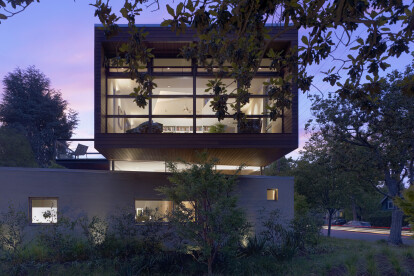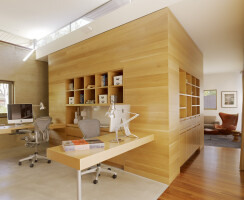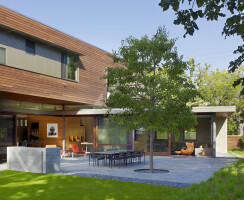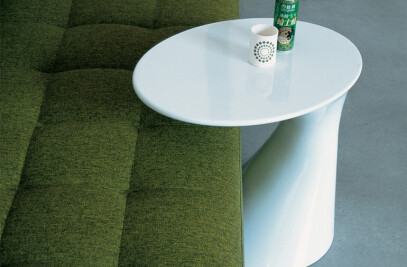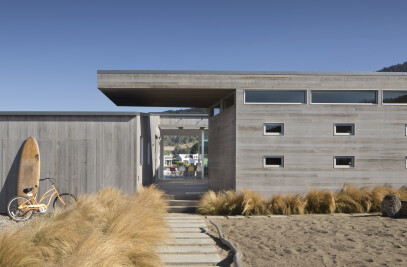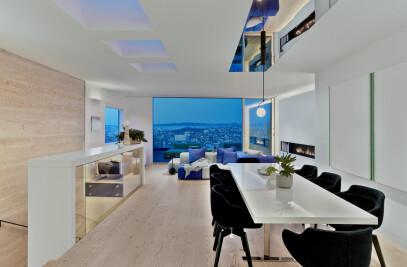CCS Architecture designed this 5,800 square foot home for a family of five in Palo Alto, California. The clients both work in the Silicon Valley, and they have 3 young children. The design is specific to their close-knit family needs as well as their rigorous sustainability standards. The architecture is contemporary, but it has warm, authentic materials and refined details to accommodate a casual, unpretentious lifestyle.
The home's bent, linear configuration divides the site; the public, street sides wrap the corner, creating a more private interior. A breezeway leads to the entry and the yard beyond, while also separating the main house from the garage and studio. The second floor bridges over these two and becomes the ceiling of the breezeway.
The lower part of the house has primary walls of highly crafted rammed earth made with soil excavated from the site. The upper floor, framed in wood and steel, is clad in wood siding plus aluminum panels. Between the two is an 18-inch ribbon of glass that admits soft light and views while making the upper floor appear as if it is floating.
Sustainability Features
• Roof-mounted solar panels include a six-kilowatt photovoltaic array to generate electricity and a thermal water panel array that provides domestic hot water. The latter also preheats the water for radiant floors throughout the house. • A high-efficiency gas boiler provides back-up heat in winter months. • A north-facing light monitor (atop the two-story stair) brings in even, north light, with operable windows to naturally flush the house of excess heat in the warm summer months. This works in concert with the low-story windows, which draw in fresh, cooler air for passive cooling. • Rammed-earth walls are pneumatically-compacted, 16-inch thick walls that wrap around the lower floors of the house. Soil from the site comprises about 50 percent of the walls' content. In addition to being a sustainable material, rammed earth has a thermal mass that helps modulate temperature fluctuations throughout the year. • Concrete foundations are made with 30% fly ash concrete. • All windows and glass doors have low-e, high performance glazing, and most are operable for natural ventilation. • The house was built on a flat, downtown lot whose previous home was carefully deconstructed to minimize waste.
Local Materials, Locally Made
• Cabinets throughout were made by Spiral Design of South San Francisco using domestic hardwood. • Wood walls were made on site by a local subcontractor, Arroyo Construction, in neighboring Menlo Park. • Dining table, master bed and bedside tables were designed by CCS Architecture and fabricated by Custom Furniture Design in San Francisco. • Built-in sofa was designed by CCS Architecture and fabricated by Kroll Furniture of San Francisco. • Aluminum metal work was by Florian Industries of Brisbane, CA. • Landscape was designed by CCS and “meadow consultant” John Greenlee. It was installed by Siteworks from Berkeley, CA, and all plants were sourced from Brisbane and Chino, CA. • Synthetic turf system is “Heavenly Green” from Northern California's exclusive Field Turf distributor. • Ipe siding, while not local, is 100 percent natural, maintenance free, and does not have chemically produced additives. Unlike other siding options, Ipe easily resists termites, mold, and wood rot. It maintains its strength even in the harshest environmental conditions. • Hardwood flooring is American walnut, sourced from Golden State Lumber in San Rafael, CA. • Concrete floors are approximately 30% fly ash, a byproduct of burning coal to generate power. Using fly ash helps reduce the energy cost and heavy environmental toll of cement production. • Aluminum windows are by Fleetwood, fabricated at a production plant in Corona, CA. • Stainless steel counters and hood were fabricated by American Metal Products, a small custom metal shop in San Francisco. • Rammed earth subcontractor is David Easton, the leading innovator of forming and delivery technologies for constructing rammed earth walls. He is California-based and specializes in custom mix designs with an emphasis on site-sourced earth.
Deconstruction of Previous House
The existing house was an unremarkable mix of styles and spaces—a 1930s structure that was haphazardly added onto over the years. The site also included a pool, which was deconstructed as well. Typically a house would be demolished and the waste shipped to a landfill. In this case, the house was deconstructed piece by piece over the course of a five-week period. Most of the materials that were not objects, such as plumbing and electrical fixtures, were broken down and shipped to nearby recycling centers. The balance of the materials were either broken down and reused in some other form, i.e. gypsum and plaster were reused as road base or filler in other construction. The ReUse People took other materials, i.e., clay roof tiles, windows and light switches, for resale.
While deconstructing the existing pool, we found the subsurface soil to be a good match as base material for the rammed earth walls of the new house. About 50% of the material in the new rammed earth walls is comprised of soil from the site.


